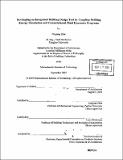| dc.contributor.advisor | Qingyan Chen and Leon Glicksman. | en_US |
| dc.contributor.author | Zhai, Zhiqiang, 1971- | en_US |
| dc.contributor.other | Massachusetts Institute of Technology. Dept. of Architecture. | en_US |
| dc.date.accessioned | 2005-06-02T16:25:06Z | |
| dc.date.available | 2005-06-02T16:25:06Z | |
| dc.date.copyright | 2003 | en_US |
| dc.date.issued | 2003 | en_US |
| dc.identifier.uri | http://hdl.handle.net/1721.1/17617 | |
| dc.description | Thesis (Ph. D.)--Massachusetts Institute of Technology, Dept. of Architecture, 2003. | en_US |
| dc.description | Includes bibliographical references (p. 237-246). | en_US |
| dc.description.abstract | Building energy simulation (ES) and computational fluid dynamics (CFD) can play important roles in building design by providing essential information to help design energy-efficient, thermally comfortable and healthy buildings. However, separate applications of ES and CFD usually cannot give an accurate prediction of building thermal and airflow behaviors due to the partial modeling of the problem. An integration of ES and CFD can eliminate many of the assumptions used in ES and CFD because of the complementary nature of ES and CFD results. This thesis studies the fundamentals, implementation and application of ES and CFD coupling, significantly advancing the knowledge and experience in this area. The study has been focused on the iterative coupling of individual ES and CFD programs, which shows good potential of providing reasonable results with acceptable computing costs. The research first analyzes the principles and challenges of ES and CFD program coupling. To bridge three major discontinuities in time-scale, spatial resolution and computing speed between ES and CFD programs, special coupling strategies have been developed. Particularly, the staged coupling strategies proposed can effectively reduce computing time while preserving the accuracy and details of the computed results. The study discusses the solution characteristics of iterative coupling simulation. Through theoretical analysis and numerical experiments, the research verifies the solution existence and uniqueness of a coupled simulation. The investigation concludes that a converged and stable simulation can be achieved with four different data coupling methods. The study has further developed an improved iteration and control algorithm for the coupled simulation. An integrated program, E+MIT-CFD, has been developed by coupling a new- generation ES program (E+) with a newly-developed ready-to-plug-in CFD solver (MIT- CFD). All the coupling methods and strategies proposed have been implemented in this program. The program has been well validated with various experimental facilities. The comparison of numerical solutions with experimental data reveals the advantages of the integrated simulation over the separate ES and CFD applications. The study further demonstrates the performance and capabilities of the coupled program through practical | en_US |
| dc.description.abstract | (cont.) through practical design projects. Finally, sensitivity analysis of the coupling simulation to building characteristics and coupling strategies has been performed, based on which general guidelines are established for appropriate usage of the coupling simulation. | en_US |
| dc.description.statementofresponsibility | by Zhiqiang Zhai. | en_US |
| dc.format.extent | 277 p. | en_US |
| dc.format.extent | 16876779 bytes | |
| dc.format.extent | 16875550 bytes | |
| dc.format.mimetype | application/pdf | |
| dc.format.mimetype | application/pdf | |
| dc.language.iso | eng | en_US |
| dc.publisher | Massachusetts Institute of Technology | en_US |
| dc.rights | M.I.T. theses are protected by copyright. They may be viewed from this source for any purpose, but reproduction or distribution in any format is prohibited without written permission. See provided URL for inquiries about permission. | en_US |
| dc.rights.uri | http://dspace.mit.edu/handle/1721.1/7582 | |
| dc.subject | Architecture. | en_US |
| dc.title | Developing an integrated building design tool by coupling building energy simulation and computational fluid dynamics programs | en_US |
| dc.type | Thesis | en_US |
| dc.description.degree | Ph.D. | en_US |
| dc.contributor.department | Massachusetts Institute of Technology. Department of Architecture | |
| dc.identifier.oclc | 54688954 | en_US |
